Hot Wet Equatorial Climate
by Devender
0 2580
- World Climate and Vegetation:
- Air temperature
- Precipitation
- World climate:
- Natural Vegetation of the World:
- Climate
- Animals
- Plants
- The Amazon Basin (South America)
- The Congo Basin (Africa)
- Malaysia
- Indonesia
- Singapore
- The average monthly temperatures are around 26 – 28 Degree C
- The small annual range of temperature is around 3 Degree C
- The Greater diurnal range of temperature is about 12 – 15 Degree C
- There is around 150 – 250 cm of rainfall or more in a year
- Presence of heavy precipitation and cloudiness
- The mountain regions also experience a lot of orographic or relief rainfall besides the convectional rainfall
- The relative humidity is constantly on the higher side at over 80 %
- It makes everyone feel very sticky and uncomfortable
- The convergence of air masses at Doldrums causes cyclonic atmospheric disturbances that also provide some intermittent showers
- Vegetation in Equatorial Regions:
- The growing season is all year round unlike the temperate regions
- Even Seeding, Flowering, Fruiting, and Decaying do not take place in seasonal patterns
- Some trees might be flowering while others in the neighbourhood may be bearing fruits
- There is an absence of cold and drought to check the growth in any part of the year
- A wide variety of ferns, orchids, and lalang (tall grass) grow under the trees
- In a rainforest, there are several layers of vegetation
- All plants struggle to move upward to get sunlight
- The uppermost layer is formed by the crown of the tallest trees
- The average heights of these trees are 45 to 60 meters
- These trees are known as emergent, their crowns are exposed to direct sunlight
- The second layer is known as Canopy
- Its average height is about 20 to 40 meters
- There is another layer below the canopy that is known as the understory
- The heights of the trees are only a few meters high
- The sunlight is very limited in this layer
- This layer contains trees that only grow to about 15 meters and saplings that maximum grow to the height of the canopy layer
- There are plants known as epiphytes which grow on trees
- These plants do not harm the trees and don’t take nutrition from the trees
- The trees are only used for physical support
- Parasites are those plants that grow on other plants and get their nutrition from them
- They damage their hosts in the process
- Life and Development in the Equatorial regions:
- Rubber is collected by the Indian tribes in the Amazon basin
- Nuts are gathered by Pygmies in the Congo basin
- Malaysia and Indonesia are the leading producers of rubber in the world currently
- Cocoa is extensively cultivated in West Africa
- Ghana and Nigeria are the two most important producers of Cocoa
- Oil palms are also doing well in these areas
- Hardwood and Livestock:
- The maintenance cost for these are also very high
- It is the chief reason why many parts of the Amazon basin and Congo doesn’t have modern communication
- Rivers are the natural transportation and highways in these areas
- Due to the absence of meadow grass, livestock farming is not optimal
- The domesticated bullocks yield milk and beef but that too far below than those in temperate grasslands
At a certain place on earth near the earth's surface, the characteristic of the atmosphere is known as the Climate of that region. Climate can be easily defined as the long-term weather of a particular area (at least 30 years).
It includes the general pattern of weather conditions, seasons, and weather extremes such as hurricanes, drought, or rainy patterns of that particular region. The climate of an area is dependent on two major factors that are –
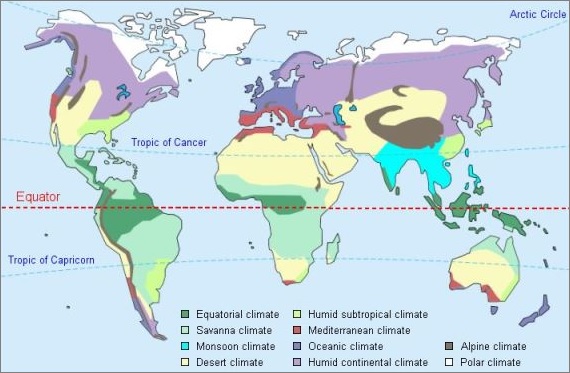
| Zone | Western Margin | Central Continent | Eastern Margin | Latitude |
| Cold Zone | Arctic or Polar Types | 65 - 90 Degree | ||
| Cool Temperate | British type | Siberian type | Laurentian type | 45 - 65 Degree |
| Warm Temperate | Mediterranean | Steppe type | China type | 30 - 45 Degree |
| Hot Zone | Hot desert | Sudan type | Monsoon type | 10 - 30 Degree |
| Equatorial Zone | Hot wet Equatorial Climate | 0 - 10 Degree |
The climate controls the habitat of the world. The climate of a region dictates which plants will grow in that region and which animals will inhabit it. The very fabric of the world’s habitat is interwoven between the three components that are –
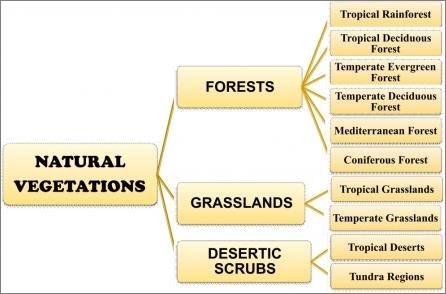
Hot Wet Equatorial Climate
This type of climate is found between 5 - 10 Degree both north and south of the Equator mainly in the following regions –
The equatorial climate has great uniformity of temperature throughout the year and winters are totally absent, it is the most outstanding feature of this climate.
The rainfall and cloudiness help to moderate the temperature in these regions so that the climate at the equator doesn’t become unbearable to live in. There isn’t a single month without rain and there is the absence of a distinct dry season such as Savanna or Tropical monsoon climate.
The torrential showers are often accompanied by thunderstorms and lighting. Most of the rainfall is convectional and the convection uplift is related to the position of the ITCZ. When the sun is overhead at the spring and autumn equinox, the rainfall totals double, and the least rainfall is noticed at June & December solstices.
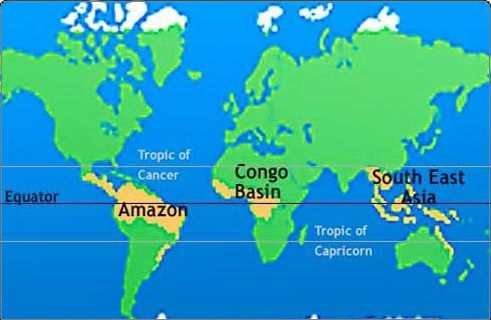
A luxuriant type of vegetation such as tropical or equatorial rain forests is supported by these regions because of all-year high temperatures and abundant rainfall. A special term Selva is used to describe the Amazon lowlands as these forests are so dense and extravagant.
In a small area of these forests, many different types of trees and plants can be found growing which is not possible in temperate forests. The rainforests only cover around 6% of the Earth’s Surface but still provide around 40% of the world’s oxygen. These forests contain nearly half of the world’s known animal species.
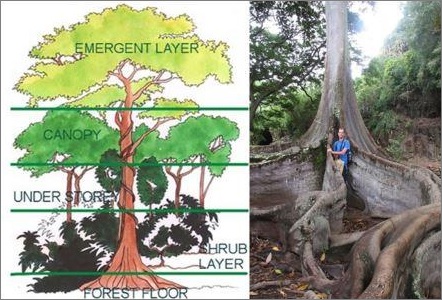
The equatorial vegetation comprises various kinds of evergreen trees that yield tropical hardwood such as Mahogany, Ebony, Greenheart, Cabinet Woods, and Dye woods. Smaller palm trees, climbing plants like lianas, epiphytic, and parasitic plants that live on other plants are also present here.
The crown of the trees in this layer forms a nearly unbroken cover for the forest floor. These trees are packed very tightly together and don’t let much sunlight reach the forest floor. When you look from above, you will not be able to see the forest floor because of the canopy layer cover.
The layer between the understory and the forest floor is known as the shrub layer. It is composed of ferns & shrubs and only 1 or 2 % of the total sunlight received by the rainforest reaches here. Only a few plants are able to live in such conditions.
To support the great heights, many trees have buttress roots also known as plank buttresses. These buttresses extend above the ground and along the trunk on all sides. In the lower layers, there are some plants that have large leaves to use the little sunlight efficiently.
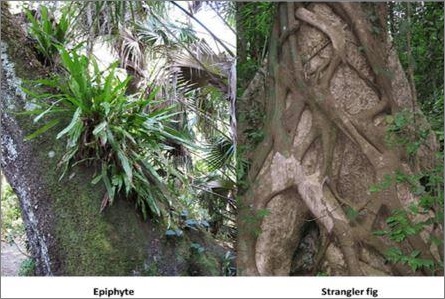
There are some plants known as lianas that are rooted in the soil but they grow up along the trunk of large trees to reach the canopy in order to get more sunlight.
There are other plants that too grow on a host tree. These plants are known as strangler figs. They grow long roots down the tree’s trunk leading into the soil. Eventually, these roots grow larger and surround the host tree’s trunk which leads to the death of the host tree. The strangler fig then takes the place of the host tree. Officials have cleared many parts of the virgin tropical rainforests either for lumbering or shifting cultivation.
Generally, the equatorial regions are hugely populated. Shifting cultivation is the major agricultural practice in this region with major crops being manioc (tapioca), yams, maize, bananas, and groundnuts. The food is abundantly present in the region in form of animals, birds, fishes. Fruits, nuts, and other jungle produce.
Some of the high-value industrial crops are grown in these regions. The equatorial climate is best suited for these crops such as rubber, cocoa, oil palms, coconuts, sugarcane, coffee, tea, etc. Brazil is the country that discovered rubber but it still doesn’t export any natural rubber because of the lack of commercial organizations of Indians present in the Amazon lowlands and tree diseases.
The conditions in these areas are very challenging because of high heat and humidity. The men exposed are subjected to physical and mental handicaps along with sunstrokes, malaria, and yellow fever. This hot and wet climate provides great conditions for rapid plant growth but it also promotes the spread of insects and pests. The germs and bacteria can easily transmit via moist air and they are injurious to all men, animals, and even plants.
These jungles are so luxuriant that clearing and maintaining small patches become a major problem as lalang & long grass take the place of trees as soon as they are shaded.
Unless these grasses are taken care of regularly, they may choke the crops and burden the estates. The roads and railways in the equatorial lands have to go through the forests and often people come across wild animals, venomous snakes, and insects.
The timber resources of these areas have great potential but commercial extraction is very difficult as trees don’t occur in homogenous stands. There is the absence of any kind of frozen surface so no logging takes place and even when the flow of the river is in the desired direction, the tropical hardwoods are sometimes too heavy to float in the river.
The soil deteriorates very rapidly with subsequent soil erosion because once the natural vegetative cover is removed; the rainfall soon washes out most of the soil nutrients.
Due to heavy rainfall and rapid decomposition of these leaves by bacteria, the soil becomes very fertile but once it is used for shifting cultivation, it loses that fertility.

Share:







Comments
Waiting for your comments